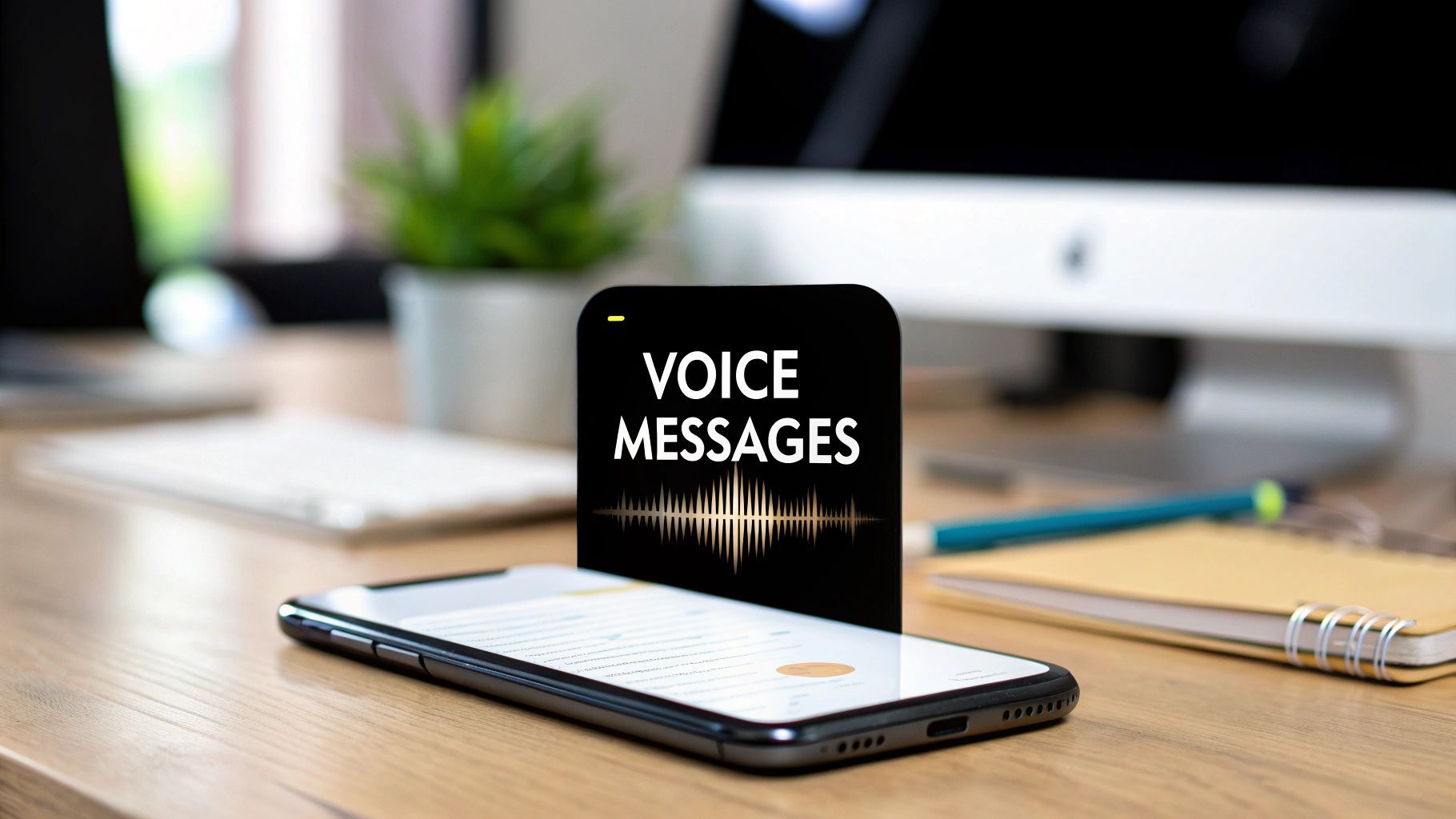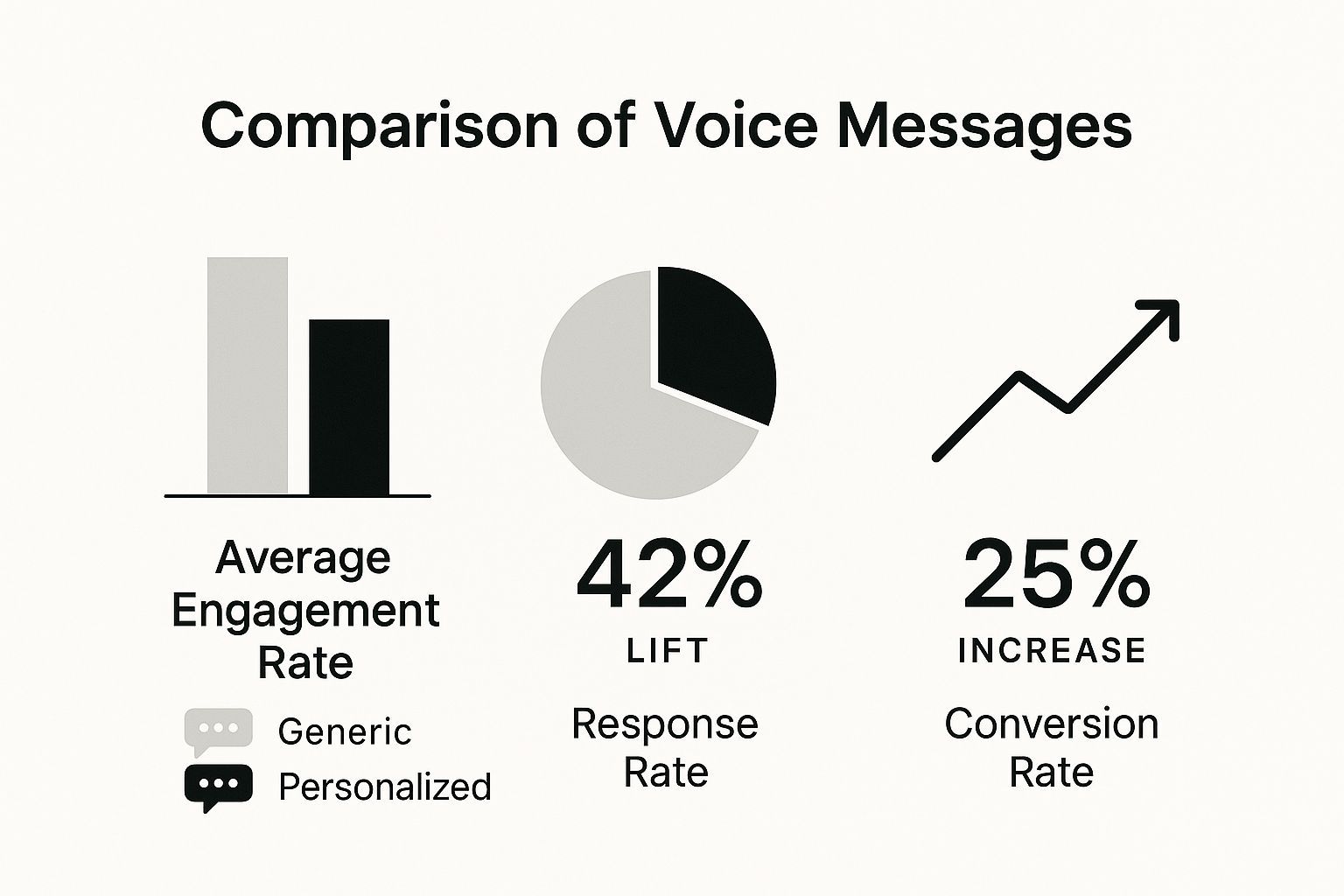Your Guide to the Modern AI Voice Actor

Video Gen Now Faster & Cheaper!



Discover how personalized voice messages create genuine human connections that convert. Our guide breaks down the strategies and tools you need to stand out.
In a world drowning in automated emails and generic text alerts, personalized voice messages have become the ultimate way to cut through the digital clutter. Forget those awful, generic robocalls. We're talking about authentic, custom-tailored audio clips sent directly to an individual, creating a genuine connection that feels immediate and real.
Just think about your inbox for a second. It's a never-ending flood of text, sales pitches, and robotic reminders. Now, imagine getting a short, friendly voice message from someone who not only uses your name but also mentions something specific to you. The difference is night and day.
Sure, text is efficient, but it's also cold and totally impersonal. The human voice, on the other hand, is rich with nuance, emotion, and personality.
This isn't just a hunch; it’s baked into our psychology. Hearing a real person's voice lights up different parts of our brain than just reading words on a screen. The tone, the pitch, the slight pause—it all communicates warmth and sincerity in a way that plain text never could. It turns a faceless digital tap on the shoulder into a real human moment, building instant rapport and trust.
It’s like the difference between getting a generic flyer stuffed in your mailbox and receiving a thoughtful, handwritten note. One gets tossed in the trash without a second thought, while the other creates a memorable experience that actually gets your attention.
Most digital outreach feels like shouting into a hurricane and just hoping someone, anyone, hears you. It’s a numbers game, plain and simple. Personalized voice messages, however, are the complete opposite. They're like pulling someone aside for a quiet, one-on-one chat. They prove you actually took a moment to think specifically about them, and in today's world, that’s a rare and valuable thing.
This simple shift completely flips the script on modern communication. Instead of being just another notification to be swiped away, a voice message feels like a gift. It's an unexpected and personal touch that can:
Create a Pattern Interrupt: A voice message shatters the monotony of endless text, forcing people to stop and pay attention. Build Real Connections: The warmth in your voice makes you or your business feel more human, relatable, and trustworthy. Supercharge Engagement: Let's be honest, people are way more likely to listen to a short message recorded just for them than to trudge through another block of generic text.
The data below isn't subtle. It shows the jaw-dropping difference between a generic blast and a personalized, voice-first strategy.

The numbers speak for themselves. Personalizing your audio outreach doesn't just give you a little bump—it completely transforms your results, driving sky-high response and conversion rates.
Let's put these two communication styles head-to-head. While both have their place, the impact they deliver and the impression they leave are worlds apart. One is like a billboard on a highway; the other is the start of a real conversation.
Attribute Traditional Text (Email, SMS) Personalized Voice Message Emotional Impact Low to neutral. Relies on emojis or punctuation to fake a tone. High. Conveys genuine emotion, sincerity, and personality. Personalization Often limited to a mail-merge field like [First_Name]. Ouch. Deeply personal through your unique tone, content, and delivery. Memorability Low. Gets lost in the endless sea of other text-based messages. High. A unique and surprising interaction that actually stands out. Trust Building Slow. Trust is built over dozens of interactions and shared content. Fast. Hearing a human voice creates an immediate sense of familiarity.
In the end, it all comes down to what you’re trying to achieve. If you just need to dump information, text is fine. But if your goal is to build relationships, spark meaningful conversations, and get people to take action, the authentic power of the human voice is your secret weapon.
Forget the theories for a second and think about what really works in the real world. Personalized voice messages aren't just another shiny marketing tactic; they represent a ground-up shift in how you can build relationships. This is how you turn cold, faceless digital pings into warm, human conversations. It’s the secret weapon that makes your brand feel less like a faceless company and more like a real person.

The biggest immediate win? It’s a total pattern interrupt. Your prospect’s inbox is an absolute warzone of ignored emails and robotic notifications. A voice message, especially one using their name and mentioning something specific, shatters that monotony. It’s so unexpected that it practically forces them to stop scrolling and actually listen. That move alone can send your open and response rates through the roof.
But getting their attention is just the start. The real magic is in the emotional connection you can create. Text is flat. It’s one-dimensional. Your voice, on the other hand, is loaded with personality, sincerity, and energy—things that are impossible to fake with words on a screen. When a customer hears your genuine tone, your brand instantly feels more trustworthy and relatable.
Let’s see how this plays out:
From Cold Lead to Warm Chat: Imagine a salesperson sends a quick, friendly voice note on LinkedIn after connecting. Instead of the usual copy-paste pitch, they say, "Hey [Name], I just saw your post about [Topic] and loved your take. Just wanted to connect and say hi." That lead is suddenly 70% more likely to respond because it feels like a real conversation, not an ambush. From One-Time Buyer to Loyal Fan: A small e-commerce shop sends a personal voice thank-you after an order. "Hi [Name], this is [Your Name] from [Brand]. I just wanted to personally thank you for your order. We're a small team, and it truly means the world to us!" That tiny gesture turns a simple transaction into a memorable experience that builds incredible brand loyalty.
This approach shifts you from being just another brand asking for their money to a trusted partner in their corner. The authenticity in your voice builds a bridge of trust that a thousand email templates could never hope to cross.
This move toward voice isn't some niche trend, either. It’s a massive wave in how people behave. The ease and personal feel of voice commands are getting woven into our daily lives, and the explosive growth of voice commerce proves it.
For instance, global voice shopping spending is on track to hit a staggering $81.8 billion by 2025. That's a huge leap from just $4.6 billion in 2021. It shows just how comfortable people are with using their voice to interact and even buy things. By adding personalized voice messages to your toolkit, you’re not just being clever—you're meeting customers exactly where they're heading.
And here’s the best part. While sending one-off messages is great, modern tools are making it possible to do this at scale without losing that personal touch. If you're curious how technology is making this happen, check out the incredible advances in AI-driven text-to-speech platforms. You can maintain that human feel even when you’re reaching out to many. This is where customer communication is going.

Alright, the idea of sending personalized voice messages sounds fantastic in theory, but how does it actually work in the real world? Let's ditch the abstract concepts and jump into a practical playbook of proven strategies across different industries.
This isn't about lofty ideas; it's about solving everyday problems with the simple, disarming power of a human voice. Whether you're trying to supercharge a sales team, delight customers, or build a die-hard community, the mission is the same: create a memorable, human connection that cuts through the digital noise and gets you noticed.
Let's be honest, for most sales teams, the biggest hurdle is just getting someone to pay attention. Cold outreach channels are completely flooded, and prospects have developed a sixth sense for spotting and swatting away generic sales pitches. This is where a personalized voice message, especially on a platform like LinkedIn, can be your ace in the hole.
The All-Too-Common Problem: A sales rep finds a great lead on LinkedIn. They send the standard text-based follow-up that sounds exactly like the ten other messages that lead has already ignored today. It gets instantly deleted, and the opportunity is dead on arrival.
The Voice Message Solution: Instead of typing out another stale pitch, the rep records a quick, 30-second voice note. "Hey [Lead's Name], just saw your company launched that new [Product Feature]—seriously cool stuff! I had a quick thought about how you could use that to hit [Specific Goal]. No pitch, just wanted to connect and say congrats."
The Winning Result: This move is brilliant for two reasons. First, it proves the rep actually did their homework. Second, the warm, genuine tone builds instant rapport. The lead is far more likely to listen and reply to a real person than to a sterile block of text, turning a chilly connection into a warm conversation.
Think of it like this: while everyone else is stuck outside a packed nightclub yelling for the bouncer's attention, your voice message is a personal invitation that gets you escorted straight to the VIP section. It’s exclusive, direct, and impossible to ignore.
In the customer success world, the name of the game is keeping customers happy and loyal. Those generic "we value your business" emails? They just don't move the needle anymore. People expect to feel seen and appreciated, and a voice message is the perfect way to create those little moments of magic.
The All-Too-Common Problem: A new customer signs up. They get a standard, automated welcome email that promptly gets buried in their inbox. They feel a bit lost, don't see the value, and end up churning within the first month.
Here’s how a simple voice message can completely change that story:
Personalized Onboarding: A customer success manager sends a warm voice message welcoming them by name and pointing out one specific feature they’ll love based on their signup info. Celebrating Milestones: Automatically send a celebratory voice message when a customer hits their one-year anniversary or achieves a major goal using your product. Proactive Check-Ins: If a user’s activity starts to drop, a quick, friendly "Hey [Name], just checking in to see if you need any help with anything!" voice message can solve problems before they even think about canceling.
For creators, influencers, and community builders, connection is everything. Your audience doesn't just want content; they crave authenticity and a feeling of direct access. Personalized voice messages are an unbelievably effective tool for making your biggest fans feel like they're part of the inner circle.
Imagine sending exclusive audio updates to your patrons or dropping personalized thank-yous to new subscribers. You could even use an AI voice generator for video to create unique content drops just for them. This isn't just posting; it's building a deep sense of belonging that a simple text update could never replicate.
The trend is clear. With the voice commerce market expected to explode to $186.28 billion by 2030, people are more than ready to engage with brands and creators through audio. It's all about meeting your audience where they are—and where they're headed next.
Let's be honest, sending a voice message can feel a bit awkward at first. But getting it right is more of an art than a science, and it’s a skill anyone can master. You don't need a slick radio voice or a professional studio. It's all about being real, being brief, and offering something of value. The goal is simple: create a tiny, memorable moment that makes someone feel like you're talking directly to them, not just another name on a list.
Think of it like this: your voice message is showing up unannounced at someone's door. To get invited in, you need to be polite, respect their time, and maybe even bring a small gift. Here, the "gift" is a nugget of useful information or a genuine compliment. Nail this, and you'll start a real conversation instead of getting tossed in the digital trash bin.
If there's one golden rule, it's this: be brief. You're asking for a slice of someone's undivided attention, which is basically gold in today's world. Aim to keep your message under 60 seconds. Honestly, if you can get it done in 30-45 seconds, even better. This isn't the time for your life story; it's a quick, punchy touchpoint.
A short message immediately shows you respect their crazy schedule. It also forces you to ditch the fluff and get straight to the good stuff. Go on for too long, and their thumb will be hovering over the delete button before you even get to your point.
This is non-negotiable. Always, always start with their name. It's the simplest, most powerful way to personalize a message. Hearing their own name is like a little jolt to the brain—it instantly tells them, "Hey, this was made just for you," separating your message from the mountain of generic spam they get every day.
It's a small psychological trick that works wonders, making the listener far more open to what comes next. It’s the audio version of making eye contact and smiling before you start talking. It grabs their attention and creates an instant one-to-one vibe.
A voice message without their name is like a letter addressed to "Current Resident." It feels impersonal and is destined for the mental trash bin. A message that starts with "Hey, Sarah..." is a conversation starter.
Your tone of voice is your secret weapon. It carries emotion, sincerity, and personality in a way text just can't touch. You don't need to be a professional voice actor, but you do need to sound like a human being. The easiest trick in the book? Smile while you speak. I know, it sounds goofy, but trust me, people can actually hear a smile. It naturally lifts your pitch and injects a dose of warmth and positive energy.
Be upbeat, but not like you just chugged three espressos. Be genuine, not like you're reading from a script. Your authenticity is what forges the connection. If you aren't a super formal person, don't pretend to be. And hey, if you're really stuck on what to say or how to say it, you can always explore tools to create a text-to-speech message that sounds natural and gets your point across clearly.
Sometimes, the hardest part is just hitting that "record" button. A simple framework can take the fear out of it and give you the confidence to send something great every time. I'm a big fan of the "Hook-Value-CTA" model.
The Hook (5-10 seconds): Kick things off with their name and a quick, personalized comment. Show them you did a tiny bit of homework. "Hey David, it's Alex from SendFame. I just saw your LinkedIn post about scaling your outreach and loved your point on authenticity." The Value (15-25 seconds): Get right to the point. What's in it for them? "It made me think of a strategy one of our clients used to double their response rates with a similar challenge. It involves a quick, personalized audio intro." The CTA (5-10 seconds): End with a casual, low-pressure call to action. Make it easy for them to say yes. "No pressure at all, but if you're curious, just reply back with a 'yes' and I can send over the one-pager. Have a great day!"
This structure keeps your message personal, valuable, and easy to act on—all while staying well under that 60-second sweet spot. It's the perfect formula for turning a cold outreach into a warm connection.
Sending a custom, one-off personalized voice message is incredibly effective. Think of it as the digital equivalent of a firm handshake and a warm smile—it builds instant rapport. But what happens when your list has hundreds, or even thousands, of names? The very idea of recording each message by hand is enough to give you a headache.
This is where the game totally changes. Imagine being able to send those unique, personal audio notes at scale, without losing a single drop of authenticity. Welcome to the world of AI voice tools, the secret weapon for businesses that demand both massive efficiency and a genuine human connection.

Platforms like SendFame are leading the charge, giving you an almost ridiculously simple way to create hyper-realistic voice messages in seconds. And no, we're not talking about those robotic, text-to-speech voices from the '90s. This is about replicating real human nuance—your nuance—at an unbelievable scale.
So, how does this sorcery actually work? The easiest way to wrap your head around it is to think of it as "mail merge for your voice." You remember mail merge from your email days, right? You’d draft one template and pop in special fields like [First_Name] or [Company_Name] to automatically customize it for every person on your list.
AI voice tools pull off the exact same trick, but with audio. Here’s how it all comes together:
Voice Cloning: First, the platform makes a digital copy of your voice. This usually means you record a few sentences so the AI can learn your unique pitch, tone, and rhythm. The end result? A stunningly realistic AI voice that sounds exactly like you. Dynamic Scripting: Next, you write a base script for your message, making sure to include variables for all the personal touches. For example: "Hey [Name], I just saw your team at [Company] is hiring for a new sales role..." AI-Powered Generation: This is where the magic happens. The tool combines your cloned voice with your script and instantly generates hundreds or thousands of unique audio files. It perfectly weaves in each person's specific details, creating a final message that sounds like you sat down and recorded it just for them.
This technology finally solves a problem businesses have been wrestling with for years: how to be personal without being slow. It lets you keep the emotional punch of a one-on-one voice message while getting the reach of a mass email campaign.
As you start looking into these solutions, getting a handle on the underlying voice and speech recognition technology is key to really getting the most out of them.
This shift toward voice isn't just a flash in the pan. It's a deep change in how people prefer to interact, supercharged by the rise of voice assistants and smart speakers in every home. And for businesses ready to jump on board, it's creating a massive opportunity.
The global voice commerce market is set to explode to an incredible USD 714.5 billion by 2034, climbing from USD 66.5 billion in 2024. That’s not just growth; it’s a rocket ship. It proves that people are getting more and more comfortable using their voices to connect and buy.
When you weave AI-powered personalized voice messages into your strategy, you’re doing more than just adopting a slick new tool. You’re putting your brand right at the heart of this audio revolution, meeting your customers in a way they’re starting to demand.
And it's not just for sales. The same tech that helps you scale outreach can unlock all sorts of creative doors. The principles of AI voice replication are popping up in fascinating ways across different fields. If you’re curious about other creative uses, check out our guide on how AI tools for musicians are opening up brand new artistic avenues. It's all part of the same big move toward more dynamic, AI-driven audio.
Let's be honest. Jumping into a new strategy, especially one that feels this personal, can bring up some serious questions. Will people think I'm a weirdo? Do I need to sound like a radio DJ? And how in the world do I know if this is actually working?
I get it. But let's tackle these common hurdles head-on. My goal is to swap that uncertainty for a clear, practical game plan. Once we're done, you'll feel confident using personalized voice messages not just as a fun gimmick, but as a killer tool for building real connections and getting real results.
This is the big one, isn't it? It’s the number one fear I hear, and it’s a totally valid concern. Nobody wants to be that person—the one sending spammy, unwelcome messages that make people cringe.
Here’s the secret: the line between a delightful surprise and an annoying intrusion comes down to one simple thing: value.
A message feels creepy when it’s all about you, completely generic, and offers nothing to the person on the other end. Think of that classic cold call that dives right into a sales pitch. Ugh. But a voice message feels like a welcome gift when it's thoughtful, relevant, and puts the other person first.
To make sure your message lands perfectly, just focus on a few things:
Do Your Homework: A quick, specific reference shows you see them as a human, not just another name on a spreadsheet. Mention a recent LinkedIn post, a company award, or a shared connection. This instantly turns a "cold" message into a warm one. Offer Help, Not a Pitch: Frame your message around them. Instead of saying, "I want to sell you my thing," try something like, "I saw you're working on X, and a quick thought popped into my head that might help." It’s a complete game-changer. Keep It Low-Pressure: End with an easy out. Something casual like, "No worries at all if you're swamped, just thought I'd share!" removes the pressure to reply. It makes the interaction feel like a friendly gesture, not a demand.
A voice message is only creepy if it’s all about you. When you make it all about them—their wins, their challenges, their world—it transforms from an interruption into a memorable moment.
Nope. Not at all. In fact, trying to sound like a polished, "professional broadcaster" can totally backfire. The real magic of a voice message is its authenticity. People are drowning in slick, overproduced marketing. What they're really hungry for is a genuine human connection.
A voice that's a little imperfect, that sounds like a real person just talking, is way more relatable and trustworthy. Your natural energy and sincere enthusiasm are what build rapport, not a flawless but sterile recording.
So, forget about buying a fancy mic or soundproofing your closet. The microphone on your smartphone or the headset you already own is more than good enough. The most important thing isn't crystal-clear audio quality; it's the sincerity they hear in your voice.
Want a pro tip? Just smile while you record. Seriously. It naturally adds warmth and energy to your tone that people can actually hear and feel on the other end. Perfection is boring; authenticity is magnetic.
This is where the rubber meets the road. A cool idea is useless if you can't prove it's making a difference. Luckily, tracking the return on investment (ROI) for personalized voice messages is surprisingly straightforward. You just have to know what to look for.
Start by tracking these key indicators:
Response Rate: This is your most immediate win. Just compare the percentage of replies you get from voice messages versus your typical emails or LinkedIn DMs. It’s not uncommon to see this number jump by 50% or more. Conversion Lift: How many people who got a voice message took the next step? Whether that's booking a demo, making a purchase, or starting a trial, you can A/B test a campaign with and without a voice message to see the direct impact. Sales Cycle Velocity: For sales teams, this is huge. Track how much faster leads who receive a voice note move through your pipeline. That personal connection builds trust and can seriously shorten the time it takes to close a deal. Customer Retention: If you're in customer success, keep an eye on the retention rates for customers who get personalized voice check-ins or thank-you messages. A small, human touch can make a massive difference in loyalty and reduce churn.
When you focus on these practical metrics, you’ll have hard data showing how a few seconds of authentic audio can directly lead to significant business growth.
Ready to stop typing and start connecting? With SendFame, you can create hyper-realistic, AI-powered voice messages at scale, maintaining that personal touch without spending hours recording. Discover how SendFame can transform your outreach today!
Create Epic
SendFame